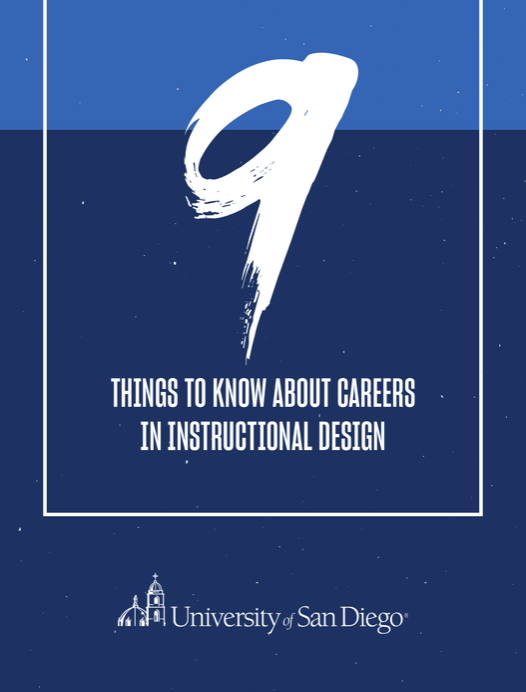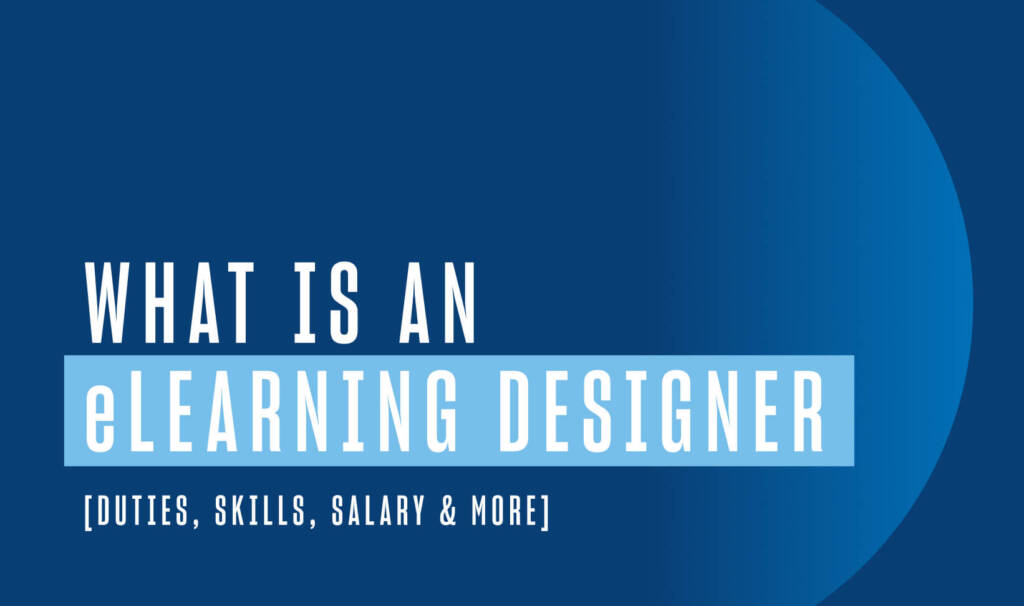In today’s digital learning environment, the instructional designer (ID) and eLearning developer positions are integral to the learning experience and are sometimes thought of as interchangeable. While one person may serve both roles in smaller organizations, it’s inaccurate to lump these positions together. IDs and eLearning developers cater to different yet equally essential needs in learning environments.
Let’s review their different responsibilities, differences in possible career paths, and how they both contribute to instructional and training goals.
What Is Instructional Design?
Instructional design includes creating and developing learning materials for educational or training purposes. Instructional designers are responsible for defining the broad outline of a course or program, choosing the appropriate pedagogical approach, and determining the skills or knowledge goals for learners.
Instructional designers work with subject matter experts (SMEs) to identify the topic(s) and specific needs of a course, such as which experiences are relevant, what knowledge learners should gain and the content areas on which to focus. Their goal is to create a compelling and memorable experience for learners that seeks to change their behavior or improve their performance.
Overview of What an Instructional Designer Does
- Holds meetings with stakeholders to understand course objectives and scope out the program.
- Analyzes learner needs and determines the most suitable design model to meet the course objectives.
- Interviews subject matter experts (SMEs) to synthesize knowledge into course materials.
- Maps out lessons and topics, including possible interactions, activities and assessments.
- Presents all materials to eLearning designer or curriculum designer for course creation.
- Participates in developing the program as needed.
[RELATED RESOURCE] Unsure which career path fits you best? Find out if instructional design aligns with your career goals.
What Is eLearning Design?
An eLearning designer is similar to a curriculum designer but specializes in online learning strategies and learning technologies. Part of this job requires planning the learning experience and creating digital instructional materials. An eLearning designer uses specific authoring tools to bring the learning experience to life, typically as an online course.
Overview of What an eLearning Designer Does
- Reviews the objectives and course design blueprint developed by the ID.
- Provides feedback on the feasibility of the design and suggests practical alternatives.
- Divides content into proposed lessons and topics and then presents a storyboard of the course to stakeholders for approval.
- Develops a prototype using rapid authoring tools like Articulate Storyline 360.
- Works with other experts to assist in designing course materials, which may include web development, video editing, and programming interactive content.
- Builds out the course, adhering to best practices for usability and accessibility for all learners.
- Tests the course to ensure:
- Videos play properly
- Audio is integrated appropriately
- Closed captions are available
- Learners can access content through multiple devices
- Troubleshooting issues are quickly addressed
Difference Between Instructional Design & eLearning Design
Instructional design is a strategic process informed by design models and learning theories, knowledge of how people learn, and best practices in organizing instructional strategies and relevant learning experiences. IDs draft learning objectives, decide what content is relevant, determine the best way to facilitate learning, and assess learning outcomes.
By comparison, eLearning design is an applied approach to using technology to produce the learning experience that requires more technical knowledge — such as utilizing specific design programs and authoring tools — to create the learning materials, design the interface and establish how learners will interact with the course and each other.
How Instructional Design & eLearning Design Work Together
Although they approach course design differently, instructional and eLearning designers often work collaboratively to combine theory, process, and learning technologies to engage learners creatively. Some common examples include:
- Storytelling — Instruction presented as interactive “stories” that ask the learners to progress along a narrative that teaches through examples.
- Scenario-based instruction — A twist on storytelling where learners face realistic scenarios, make decisions and learn from seeing how their choices play out.
- Gamification — The use of game concepts like leveling up, achievements, earning points and tracking leaderboards to motivate and engage the learners.
- Simulation — Instruction presented in a “fail-safe” way so that learners can experience making decisions in an environment without the pressures of real-life consequences (ex: customer service software sandbox and augmented reality medical training).
Both designers will also collaborate to evaluate the course and incorporate feedback in the revision. The ID will handle recommended content changes while the eLearning designer will focus on proposed functionality changes.
Instructional designers can take on both roles if they work in smaller organizations; however, the jobs are different, and each requires distinct skill sets to maximize their contributions to developing effective learning solutions.
Sample Programs Used for eLearning and Instructional Design
Beyond the commonly used authoring tools like Articulate Storyline 360, designers can make use of the following programs when designing courses:
- Aha Slides — This web-based application allows you to create presentation slides with interactive elements like polls, quizzes and Q&A sessions.
- AnswerGarden — A free-to-use online word cloud application where you can ask a question and the results are automatically generated based on responses.
- Crowdsignal — A tool designed to quickly create polls and surveys that can be used within multiple applications or shared via email.
- PollEverywhere — An online engagement tool that makes use of surveys, quizzes, word clouds and live polling.
- Sli.do — Designed to allow interaction within hybrid meetings, this application features live polls, quizzes and word clouds that can be used across a host of different applications.
- Canva — A freemium web-based graphic design tool that allows you to collaborate when making any type of visual aid, banner, poster, slide or document for learners.
- GoogleDocs, GoogleSlides, GoogleSheets — The Google suite of programs offers a free web-based array of programs that allow you to collaborate on ideas and deliverables using shareable documents.
These are just a handful of the available tools and applications used to create courses and training programs. To read about additional software applications, see our blog post: Top 15 Tools Used by Instructional Designers.
Job Outlook for Instructional Designers & eLearning Designers
With ongoing demand for educational and training materials across academia and the corporate world, the career outlook for positions such as instructional designer and eLearning designer appears strong. While the U.S. Bureau of Labor Statistics doesn’t specifically track ID positions or eLearning positions, it does project an 8% growth for training and development specialists through to 2031, faster than the average for all occupations.
For those looking forward to a career in instructional design or similar positions, here’s what to expect regarding responsibilities and average salaries*:
- Instructional Designer – Featuring a base salary that ranges from $55,183 to $69,903 per year, this position is responsible for designing instructional strategies, conducting training for others, integrating technology into teaching and training environments and evaluating new eLearning technology.
- Learning Consultant – Featuring a base salary that ranges from $68,087 to $88,261 per year, this position works directly with educators to ensure that all instructional design goals are being met. Learning consultants evaluate existing curriculum and resources, analyze performance metrics and then make recommendations to implement new or updated learning initiatives to improve results.
- Corporate Trainer – Featuring a base salary that ranges from $51,462 to $66,743 per year, this position provides training directly to employees and works with employers to help design and coordinate their professional development programs. As part of the job, corporate trainers are expected to be knowledgeable about organizational training goals and current training methodologies.
The future possibilities are very positive for positions in eLearning, as the global eLearning market is expected to reach $238 billion by 2024. Anyone looking to get into a career related to eLearning should consider the following positions:
- eLearning Developer – Featuring a base salary that ranges from $68,380 to $84,240 per year, this position is responsible for the design and implementation of online courses using learning technologies and applications. To excel in their position, eLearning developers need to be comfortable using different authoring tools to create instructional content for multiple learning modalities.
- Instructional Technologist – Featuring a base salary that ranges from $42,761 to $77,409 per year, this position oversees the effective integration of hardware and software into educational environments. Instructional technologists work directly with faculty to determine how technology can enhance the curriculum and how to meet different learner needs, including accessibility and learning disabilities.
- Training and Development Specialist – Featuring a base salary that ranges from $56,958 to $76,640 per year, this position plans, conducts and administers corporate programs related to training and instruction. These specialists also evaluate current training programs and research possible new technology training tools and resources.
*Salaries sourced from Salary.com in September 2022. Salary estimates may vary over time or due to location and experience.
[FREE GUIDE] Ready to pursue an in-demand role? Discover how instructional design can help you advance your career.
Advance Your Career with USD LDT
If you’re interested in the learning design process and how it relates to eLearning, consider exploring the online Master of Science in Learning Design and Technology degree program at the University of San Diego. This innovative master’s program is designed to meet the needs of aspiring learning designers who work with modern digital technologies.
MS-LDT introduces students to the concepts of eLearning and the basics of course design through Articulate 360 within the first semester. Our graduates are also expected to complete the program by developing an eLearning project as part of their capstone project.
The MS-LDT program understands the importance of coordinating instructional design concepts and eLearning development practice, which is why our students are exposed to eLearning throughout their program of study. If you’re interested in being able to market yourself as an ID with eLearning development experience, contact us today.

![Instructional Designer vs. eLearning Developers [Career Comparison]](https://onlinedegrees.sandiego.edu/wp-content/uploads/2023/03/ldt_blog_idvselearningdev.png)

![What Does an Instructional Designer Do? [Career Info & FAQs]](https://onlinedegrees.sandiego.edu/wp-content/uploads/2021/08/ldt_blog_whatdoesiddo-1024x576.png)

